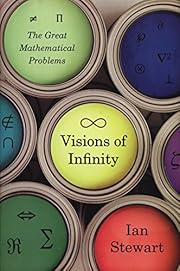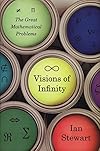

Click on a thumbnail to go to Google Books.
|
Loading... Visions of Infinity: The Great Mathematical Problems (2013)by Ian Stewart
 No current Talk conversations about this book.   ) )Yet another book on the great problems in mathematics that have attracted great prize money. Yet not just another such book; Stewart has a gift for explaining the problems and their solutions at a level just about right for an educated non-mathematician. Stewart has, in fact, almost succeeded in convincing me that I have some idea what Hodge's Conjecture is about, which is impressive, given that the last couple of books I've read that mention it more or less throw up their hands and say "This one is so abstract we can't even explain the statement of the problem properly" and make no attempt. Stewart starts out easy, with number theory, giving Euclid's proof that there is no largest prime as an example of what mathematicians mean by a proof. He then looks at Diophantine equations in general, with a pretty nifty discussion of Pythagorean triples as rational points on the unit circle. You can generate more Pythagorean triples by taking the triples you already have, turning them into rational complex numbers, multiplying or inverting them, and turning them back into triples. One of those things that made me laugh out loud when I saw it, because it was so elegant. (I guess you have to have a little mathematician in you.) From there the discussion works through modular equations via elliptic equations, which I actually studied in college, because they're also solutions of the exact equation of motion of the pendulum (if memory serves.) Winds up telling us how Andrew Weil -- excuse me, Sir Andrew Weil -- finally proved Fermat's Last Theorem. Beats slaying a dragon. Then into topology and the Four Color Theorem. Whose solution really didn't make mathematicians happy, because it boiled down to showing that every map in the plane can be reduced to one of about 10,000 cases, then writing a computer program to look at each of those 10,000 cases in turn and show that four colors was enough. That seemed like dirty pool, because it wasn't really a human being who did it. Well, that's becoming the way a lot of math is done nowadays. From there to Poincare's Conjecture, and the first problem where just stating the problem takes some 'splaining. Poincare's Conjecture is that every simply connected closed 3-manifold is homeomorphic to the 3-sphere. Um, okay: A 3-sphere is the surface satisfying the equation x^2 + y^2 + z^2 + w^2 = 1. It's a three-dimensional surface in 4-space, analogous with the 2-dimensional surface of a sphere in 3-space, like the surface of the earth. Stewart suggests we think of the 3-sphere as a solid sphere, except the outer surface maps to a single point. (That actually does mean something. Think affine mapping in complex analysis, if you're an engineer or scientist, with the point at infinity.) Simply connected: Every curve between any two points in the surface can be continuously transformed into any other curve between the same two points, meaning there are no holes in the surface. Homeomorphic: You can twist and pull and stretch and crunch a surface into any other surface it's homeomorphic with without cutting or tearing it. Perelman famously proved Poincare's Conjecture, then got upset that it took mathematicians two years to work through his proof and decide it was correct. So upset that he's turned down the million-dollar prize that goes with finding the proof. My son is getting really interested in math; I told him if he ever solves one of these prizes, don't get put out of joint and turn down the money. He was okay with that. A fair discussion of the Reimann Hypothesis, not as good as Derbyshire's, but then this is a single chapter rather than a whole book. The P/NP problem, also better treated by an entire book by a different author (which I reviewed here but am too lazy to dredge up.) A discussion of the other Millennium problems: Yang-Mills mass gap, existence of solutions to the Navier-Stokes equations, Birch--Swinnerton-Dyer Conjecture, Hodges' Conjecture. The Yang-Mills problem comes out of physics; it's to prove that for any compact simple gauge group, there's a solution of the corresponding Yang-Mills equations and it has a mass gap. Stewart doesn't get much into the math on this one, preferring to talk about LHC and the Higgs boson. Navier-Stokes also comes out of physics; these equations describe viscous incompressible fluid dynamics. Numerical solutions tend to be ugly, due to turbulence, and the question is whether you are even guaranteed a unique solution for given initial conditions. Birch--Swinnerton-Dyer was conjectured by, um, Birch and Swinnterton-Dyer (there was a reason for those two hyphens) and was something they stumbled across crunching numbers on a big computer: It's hard to state so an educated layman can understand, but the idea is that there is a connection between the group of points representing rational solutions of an elliptic equation and the analytic properties of the elliptic equation around its pole at z=1. It's related to Fermat's last theorem, distantly, with a touch of Reimann's Hypothesis thrown in. Hodge's Conjecture: Stewart admits it is real hard even to explain the statement of the conjecture, let alone to prove or disprove it, but I get the idea that it is a conjecture about whether certain mathematical descriptions of hypersurfaces are sufficient to fully characterize the topology of the hypersurfaces. Well, that's a better understanding that any other author has so much as attempted, so it wins Stewart a gold star. Stewart thinks the mass gap hypothesis will be proven soon; that Navier-Stokes will take a bit longer and will be disproven (no guarantee of a smooth solution); that Reimann may be proven before the end of the century; that Birch--Swinnerton-Dyer will also be proven in the next century; and that Hodge's Conjecture will be disproven. He can't say why, except that it just "smells" wrong. He thinks the hardest of these will be P-NP, which he half expects to turn out to be a Godel statement -- cannot be proven nor disproven. I may not be ready to read Weil's 300 pages of proof of Fermat's Last Theorem, but at least I understand a little better the outline of what he did. And there are a lot of nifty easier examples along the way to each of these hard problems. Recommended. Unclear exposition of almost everything except Kepler conjecture and Three-body problem. Even in the end when the author "introduces" 12 unsolved problems of his own selection, he seems to be confused about what the actual problems are and what the actual conjectures say. No matter how many times you read the poorly-written chapters and section, you won't gain clear insight into the problems. 2 stars only because the chapters on Kepler conjecture and Three-body problem are fairly clear, should actually deserve 1. Accomplished math popularizer Stewart here discusses 14 longstanding problems that have either been solved relatively recently (e.g. 4-color, Fermat's Last Theorem) or are still unsolved (e.g. P=NP?, Riemann Hypothesis). Even though the chapter on the Hodge conjecture seeks to explain "On any non-singular projective complex algebraic variety, any Hodge class is a rational linear combination of classes of algebraic cycles." (!), the chapter on the conjecture of Birch and Swinnerton-Dyer is where I got the most lost. no reviews | add a review
Notable Lists
"Overview of the most formidable problems mathematicians have vanquished, and those that vex them still"--Dust jacket flap. No library descriptions found. |
Current DiscussionsNonePopular covers
 Google Books — Loading... Google Books — Loading...GenresMelvil Decimal System (DDC)510Natural sciences and mathematics Mathematics General MathematicsLC ClassificationRatingAverage: (3.61) (3.61)
Is this you?Become a LibraryThing Author. |
||||||||||||||||||||||||||||||||||||||||||||||||||||||||||||||||||||||||||||||||||||||||||||||||||||||||||||||||||||||||